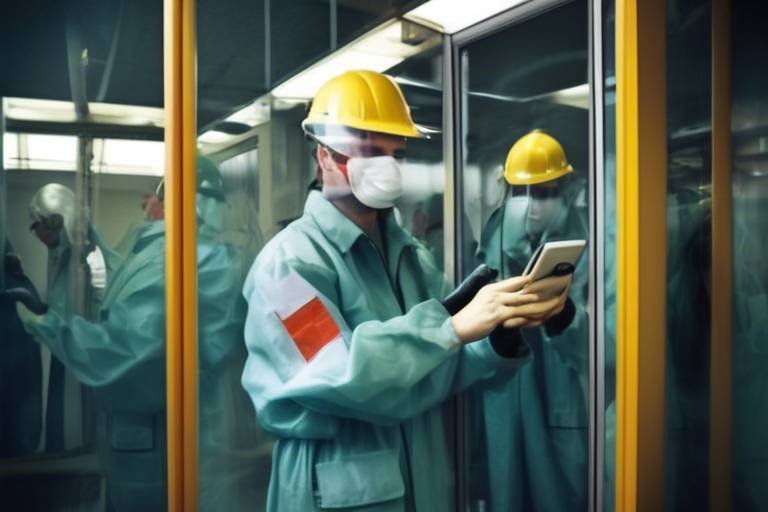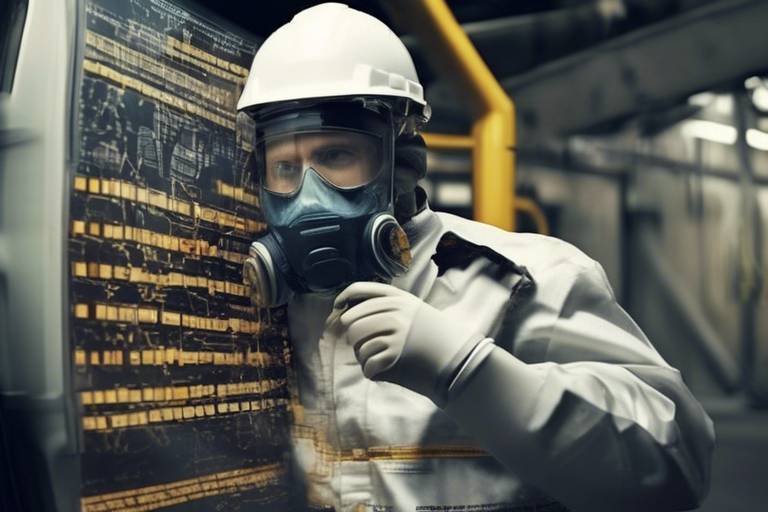Safety Measures: A Reflection on Human Behavior
In a world where safety is paramount, understanding the intricate relationship between human behavior and safety measures becomes essential. Have you ever wondered why some individuals meticulously follow safety protocols while others seem to disregard them entirely? This disparity often stems from a complex web of psychological factors that influence our actions in various environments. By delving into these factors, we can gain valuable insights that not only improve our safety protocols but also enhance our overall well-being.
When we examine human psychology, it becomes evident that our behaviors and attitudes towards safety are not merely based on knowledge or training. Instead, they are deeply rooted in our perceptions, experiences, and even our cultural backgrounds. For instance, consider how an individual raised in a safety-conscious environment might react differently to a potential hazard compared to someone from a more relaxed background. This highlights the need for a nuanced approach to safety measures—one that takes into account the psychological triggers that either promote or hinder compliance.
The environment we inhabit plays a pivotal role in shaping our behaviors concerning safety. Think about it—how often do you find yourself following safety protocols in a well-designed space compared to a cluttered or poorly laid out one? Factors such as design, layout, and accessibility can significantly influence our adherence to safety measures. For example, a workplace with clearly marked exits and well-organized equipment naturally encourages safer behavior. In contrast, a chaotic environment can lead to confusion and negligence. Therefore, it’s crucial for organizations to invest in creating environments that promote safety.
Identifying psychological triggers that encourage safety compliance is key to fostering a culture of safety. These triggers can range from emotional responses, such as fear, to cognitive evaluations of risk. For instance, when individuals perceive a high level of risk, they are more likely to engage in safety behaviors. Organizations can leverage this by developing strategies that highlight the potential dangers associated with neglecting safety measures. By creating awareness around these triggers, we can encourage safer behaviors across various settings.
Fear is a powerful motivator, especially when it comes to decision-making regarding safety. Understanding how fear and risk perception influence our choices can lead to more effective safety campaigns. For example, consider the impact of a well-crafted advertisement that showcases the consequences of ignoring safety measures. Such campaigns tap into our emotions and experiences, making the message resonate on a personal level. By appealing to our fear of potential harm, organizations can drive home the importance of adhering to safety protocols.
Social dynamics play a significant role in shaping individual safety behavior. Peer pressure and group norms can either encourage or discourage safe practices. When safety becomes a shared value within a community, individuals are more likely to comply with safety measures. This highlights the importance of community engagement in safety initiatives. By fostering a culture of safety among peers, we can create an environment where individuals feel supported in making safe choices.
Cultural beliefs and values shape our attitudes towards safety in profound ways. Different cultures may have varying perceptions of risk and adherence to safety measures. For instance, in some cultures, there may be a strong emphasis on collective responsibility, leading to higher compliance with safety protocols. On the other hand, cultures that prioritize individualism might see a more relaxed approach to safety. Understanding these cultural nuances is essential for developing effective safety strategies that resonate with diverse populations.
As technology continues to evolve, its integration into safety measures has transformed how we interact with our environments. From automated safety alerts to wearable technology that monitors our health, these tools offer unprecedented opportunities to enhance safety. However, this raises questions about our dependency on technology. Are we becoming too reliant on these tools, potentially compromising our instinctual safety behaviors? Striking a balance between leveraging technology and maintaining personal vigilance is crucial for effective safety practices.
Effective training and education programs are vital in fostering a culture of safety. These programs equip individuals with the knowledge and skills necessary to prioritize safety in their daily lives. By engaging participants in interactive training sessions that emphasize real-world applications, organizations can create a lasting impact. Consider incorporating scenarios that challenge individuals to think critically about safety decisions. This hands-on approach not only reinforces learning but also empowers individuals to take ownership of their safety.
Regular evaluation of safety measures is crucial for identifying areas of improvement and ensuring that strategies align with human behavior and environmental factors. By conducting assessments and gathering feedback, organizations can adapt their safety protocols to better meet the needs of individuals. This iterative process not only enhances safety but also fosters a culture of continuous improvement. Remember, safety is not a one-time effort; it requires ongoing commitment and adaptation to changing circumstances.
- What are the most common psychological barriers to safety compliance?
- How can organizations improve safety culture?
- What role does technology play in enhancing safety?
Common barriers include a lack of awareness, complacency, and underestimating risks.
Organizations can improve safety culture by fostering open communication, providing regular training, and recognizing safe behaviors.
Technology can enhance safety through real-time monitoring, alerts, and providing data for informed decision-making.

[Understanding Human Behavior in Safety]
When we talk about safety, it’s easy to think of rules and regulations. But have you ever paused to consider the underlying human behavior that drives our compliance or disregard for these measures? Understanding human psychology is crucial in crafting effective safety protocols. It’s not just about the rules; it’s about how people perceive and react to them. For instance, why do some individuals diligently wear helmets while cycling, while others ride without a care in the world? The answers lie deep within our psychological makeup.
One major aspect of human behavior is the tendency to underestimate risks. Many people believe that accidents happen to "other people," creating a false sense of security. This phenomenon is often referred to as the "optimism bias." It leads us to take unnecessary risks, thinking that we are invulnerable. For example, a construction worker might skip wearing safety goggles, believing that they won't be the one to get hit by flying debris. This mindset can be detrimental, emphasizing the need for effective communication about the real dangers present in various environments.
Another significant factor is the influence of social norms. Humans are inherently social creatures, and our behaviors are often dictated by those around us. If a group of friends decides to forgo seat belts during a road trip, an individual may feel pressured to conform, even if they know it’s unsafe. This is where community engagement becomes vital; by fostering a culture that prioritizes safety, we can shift these social norms to encourage safer behaviors. When individuals see their peers practicing safety measures, they are more likely to follow suit.
Moreover, the role of emotional triggers cannot be overlooked. Fear is a powerful motivator. When people are confronted with the potential consequences of unsafe behavior—like graphic images of accidents—they may be more inclined to adhere to safety measures. Campaigns that resonate emotionally can lead to significant changes in behavior. For instance, a public service announcement depicting the aftermath of a texting-while-driving incident can instill fear and provoke a change in attitudes towards mobile phone use while driving.
To better understand these dynamics, researchers often employ various methods, including surveys and observational studies, to gather data on how individuals respond to safety measures. This data can reveal patterns in behavior, helping organizations to tailor their safety campaigns more effectively. By considering the psychological triggers that encourage compliance, organizations can create tailored strategies that resonate with their target audience.
In conclusion, understanding human behavior in the context of safety is not just an academic exercise; it’s a practical necessity. By recognizing the psychological factors at play, we can develop better safety protocols that not only inform but also engage individuals on a deeper level. The goal is to create an environment where safety becomes second nature, rather than an afterthought. After all, when safety measures are aligned with human behavior, the chances of compliance significantly increase, leading to a safer world for everyone.

[The Role of Environment in Safety]
The environment we find ourselves in plays a pivotal role in shaping our behaviors, especially when it comes to safety. Think about it: have you ever noticed how a well-lit street makes you feel safer compared to a dimly lit alley? This is not just a coincidence; the design and layout of our surroundings can significantly influence our adherence to safety measures. Environments that are thoughtfully designed promote safe behaviors, while those that are chaotic or poorly structured can lead to accidents and unsafe practices.
For instance, in workplaces, the arrangement of equipment and pathways can either facilitate safety or create hazards. A cluttered workspace can lead to trips and falls, while a well-organized area encourages individuals to move safely and efficiently. Moreover, accessibility is crucial; if safety equipment is hard to reach, people are less likely to use it. This brings us to the concept of environmental psychology, which studies how our surroundings impact our thoughts and actions.
Moreover, the physical environment can trigger certain psychological responses. For example, bright colors are often used in safety signage because they catch our attention quickly, alerting us to potential dangers. Similarly, the presence of safety barriers can provide a sense of security, making individuals more likely to follow safety protocols. In essence, a well-designed environment can act as a silent guardian, nudging us towards safer choices without us even realizing it.
To illustrate this further, let's consider a table that summarizes how different environmental factors influence safety behaviors:
| Environmental Factor | Influence on Safety Behavior |
|---|---|
| Lighting | Enhances visibility, reduces accidents |
| Layout | Facilitates safe movement, minimizes hazards |
| Signage | Informs and reminds individuals of safety protocols |
| Accessibility | Encourages the use of safety equipment |
It's also important to consider how social environments impact safety. In settings where safety is prioritized, such as schools or community centers, individuals are more likely to adopt safe behaviors. This can be attributed to the social norms established within those environments. When everyone around you is focused on safety, it creates a culture where safe practices are the expected behavior. On the flip side, if you’re in an environment where safety is disregarded, it can lead to a dangerous mindset where individuals feel invincible and take unnecessary risks.
In conclusion, the role of the environment in safety cannot be overstated. From the design of physical spaces to the establishment of social norms, our surroundings have a profound effect on our behavior. By creating environments that promote safety, we can significantly reduce the likelihood of accidents and foster a culture of safety that benefits everyone.
- How can I improve safety in my workplace?
Start by assessing the physical layout and identifying potential hazards. Implement regular safety training and encourage open communication about safety concerns.
- What role does lighting play in safety?
Good lighting enhances visibility, which is crucial for preventing accidents, especially in areas with high foot traffic.
- How can social influences affect safety behaviors?
When safety is prioritized by peers, individuals are more likely to adopt safe practices, creating a positive feedback loop of safety adherence.

[Psychological Triggers for Safety Compliance]
When we think about safety compliance, it's easy to overlook the intricate web of psychological triggers that influence our behavior. Understanding these triggers is essential for organizations aiming to enhance safety protocols. For instance, one of the most powerful motivators is the concept of self-preservation. This instinct drives individuals to act in ways that protect themselves from harm. However, it's not just about instinct; our decisions are also swayed by emotional responses, social dynamics, and cognitive biases.
One of the key psychological triggers is fear. Fear can be a double-edged sword; while it can motivate individuals to adhere to safety measures, excessive fear can lead to avoidance or denial. For example, consider a workplace where employees are constantly bombarded with alarming statistics about accidents. Instead of fostering compliance, this might create an atmosphere of anxiety, leading employees to ignore safety protocols altogether. Thus, it’s crucial to strike a balance: instilling a healthy sense of caution without overwhelming individuals with fear.
Another significant trigger is social proof. Humans are inherently social creatures, and we often look to others to guide our behaviors. If a person observes their peers consistently following safety protocols, they are more likely to do the same. This phenomenon highlights the importance of fostering a culture of safety within organizations. When safety becomes a shared value, compliance rates can soar. For instance, consider a team where safety discussions are part of regular meetings. This not only normalizes safety practices but also encourages individuals to hold each other accountable.
Additionally, the role of positive reinforcement cannot be understated. When individuals receive recognition or rewards for adhering to safety measures, it creates a psychological association between safe behavior and positive outcomes. This can be as simple as a shout-out in a team meeting or a more structured reward system. Over time, these positive experiences can transform safety compliance from a chore into a valued practice.
Moreover, understanding the cognitive biases that affect our decision-making is crucial. For instance, the optimism bias leads many to believe that accidents won’t happen to them. This can result in complacency regarding safety measures. Organizations can combat this bias by sharing real-life stories of incidents and near-misses, making the risks more tangible and relatable. When individuals can envision themselves in similar situations, they may be more likely to take safety seriously.
In summary, the interplay of psychological triggers such as fear, social proof, positive reinforcement, and cognitive biases significantly influences safety compliance. By recognizing and addressing these factors, organizations can develop more effective safety protocols that resonate with individuals on a deeper, psychological level.
- What are psychological triggers? Psychological triggers are emotional or cognitive stimuli that influence our behavior and decision-making processes.
- How does fear affect safety compliance? While fear can motivate individuals to adhere to safety measures, excessive fear may lead to avoidance or denial of risks.
- What role does social proof play in safety behavior? Observing peers follow safety measures can encourage individuals to comply as well, highlighting the importance of a safety culture.
- How can organizations improve safety compliance? By understanding psychological triggers and implementing strategies such as positive reinforcement and effective communication, organizations can enhance compliance rates.

[Fear and Risk Perception]
When it comes to safety, fear often plays a pivotal role in shaping our decisions and behaviors. It's fascinating how our minds work, isn't it? Imagine walking into a dark alley; the moment you feel that twinge of fear, your instincts kick in. This emotional response is not just a reaction; it’s a complex interplay of risk perception and psychological triggers. Understanding this relationship can help us create more effective safety measures that resonate with people on a deeper level.
Fear can be a double-edged sword. On one hand, it can motivate individuals to take necessary precautions, such as wearing a helmet while biking or using seat belts in cars. On the other hand, excessive fear can lead to avoidance behaviors, where individuals ignore safety measures altogether because they feel overwhelmed. This contradiction is where the psychology of risk perception comes into play. People assess risks based on their experiences, knowledge, and emotional responses rather than objective data. For instance, if someone has had a close call in a car accident, their perception of risk associated with driving may skyrocket, leading them to be overly cautious or even anxious about getting behind the wheel.
To illustrate this, consider the following table that summarizes different factors influencing fear and risk perception:
| Factor | Description |
|---|---|
| Personal Experience | Previous incidents can heighten fear and alter risk perception. |
| Media Influence | News reports about accidents can create a heightened sense of danger. |
| Social Norms | Perceptions of risk can shift based on what peers consider safe or dangerous. |
| Cultural Background | Cultural beliefs can shape how risks are perceived and managed. |
It’s also essential to recognize that fear isn’t universally negative. In fact, it can serve as a powerful motivator for change. Consider safety campaigns that effectively tap into our emotions—these campaigns often use fear to highlight potential dangers in a way that encourages proactive behavior. For example, advertisements showing the consequences of drunk driving can be jarring, but they can also lead to significant changes in behavior.
Moreover, understanding the nuances of fear and risk perception can help organizations tailor their safety protocols. By addressing the emotional aspects of safety, they can create a culture where individuals feel empowered to engage in safer behaviors. This might involve integrating stories and testimonials into training sessions, allowing people to connect emotionally with the material. After all, a story about someone who suffered due to neglecting safety measures can be far more impactful than a statistic.
In conclusion, fear and risk perception are intertwined in a way that significantly influences our approach to safety. By acknowledging these psychological factors, we can develop more effective strategies that not only inform but also resonate with individuals, ultimately fostering a safer environment for everyone.
- What is risk perception? Risk perception refers to the subjective judgment people make about the characteristics and severity of a risk.
- How does fear influence safety behavior? Fear can motivate individuals to take precautions but can also lead to avoidance behaviors if it becomes overwhelming.
- Can safety campaigns be effective if they use fear? Yes, when used appropriately, fear can be a powerful motivator for change in safety behaviors.
- What role does personal experience play in risk perception? Personal experiences can significantly heighten an individual's perception of risk, often leading to more cautious behavior.

[Social Influences on Safety Behavior]
When we think about safety, we often focus on the rules and regulations that govern our behavior. However, what many people overlook is the profound impact of social influences on our safety behaviors. Have you ever noticed how your friends' actions can sway your decisions? This phenomenon is not just a casual observation; it's a psychological reality that plays a significant role in how we adhere to safety measures.
Consider this: when you’re in a group setting, such as at a workplace or during a social gathering, the behavior of those around you can either encourage or discourage safe practices. If everyone is wearing their safety gear, you’re likely to follow suit. Conversely, if you see others ignoring safety protocols, you might feel tempted to do the same. This is often referred to as peer pressure, and it can be a powerful motivator—whether positively or negatively.
Social norms also shape our perceptions of safety. For example, in a community where safety is prioritized—think of neighborhoods with active safety committees or workplaces that emphasize health and safety—individuals are more likely to adopt safe behaviors. On the flip side, in environments where safety is taken lightly, individuals may disregard important precautions. This creates a cycle where unsafe behaviors become normalized, making it even harder to implement effective safety measures.
Moreover, group dynamics can create a sense of accountability. When individuals feel that their actions are being observed by others, they are more likely to adhere to safety protocols. This is especially true in professional settings where team members rely on one another to maintain a safe environment. The desire to fit in and be seen as responsible can drive individuals to act more cautiously. Conversely, in situations where safety is not a shared value, individuals may feel less compelled to follow guidelines.
To illustrate the impact of social influences on safety behavior, let's consider a few key factors:
| Factor | Effect on Safety Behavior |
|---|---|
| Peer Pressure | Can lead to either increased compliance or disregard for safety measures based on the group's behavior. |
| Social Norms | Establishes expectations for safe behavior within a community or organization. |
| Accountability | Encourages individuals to prioritize safety when they know others are watching. |
In conclusion, understanding the social influences on safety behavior is crucial for developing effective safety initiatives. By fostering a culture of safety within communities and organizations, we can leverage these social dynamics to promote safer behaviors. Engaging individuals through community programs, team-building exercises, and open discussions about safety can significantly enhance compliance and create a more secure environment for everyone. So next time you think about safety, remember that it's not just about rules—it's about the people around us and the culture we create together.
- What is the role of peer pressure in safety behavior? Peer pressure can either encourage or discourage safe practices, depending on the behavior of those around us.
- How do social norms influence safety? Social norms establish expectations for behavior, making individuals more likely to follow safety protocols if they are the norm in their environment.
- Can group dynamics affect safety compliance? Yes, when individuals feel accountable to their peers, they are more likely to adhere to safety measures.

[Cultural Attitudes Towards Safety]
When it comes to safety measures, cultural attitudes play a pivotal role in shaping how individuals perceive risks and respond to precautions. Different societies have unique beliefs and values that influence their approach to safety, often dictating whether certain measures are embraced or disregarded. For instance, in cultures that prioritize collectivism, there may be a stronger emphasis on community safety, leading to higher compliance with safety protocols. Conversely, in more individualistic societies, personal freedom and autonomy might overshadow collective safety, resulting in a more relaxed attitude towards compliance.
Understanding these cultural nuances is crucial for organizations aiming to implement effective safety measures. For example, in cultures where hierarchy is respected, safety instructions delivered from authority figures may be more readily accepted. On the other hand, in cultures that value egalitarianism, safety messages might need to be framed in a way that encourages dialogue and participation among all members. This difference in approach can significantly impact the effectiveness of safety campaigns and the overall adherence to safety measures.
Additionally, cultural attitudes towards risk can vary widely. In some cultures, risk-taking is seen as a necessary part of life, leading to a more cavalier attitude towards safety measures. In contrast, other cultures may view risk with trepidation, fostering a more cautious approach. This perception can be influenced by historical events, societal norms, and even media portrayals of safety incidents. For instance, if a society has experienced frequent accidents or disasters, it may develop a heightened awareness of safety, resulting in stricter adherence to safety protocols.
To illustrate this further, consider the following table that summarizes various cultural attitudes towards safety:
| Cultural Context | Attitude Towards Safety | Compliance Behavior |
|---|---|---|
| Collectivist Cultures | Emphasis on community and group safety | Higher compliance with safety measures |
| Individualistic Cultures | Focus on personal freedom and choice | Variable compliance; may prioritize personal autonomy |
| Risk-Averse Cultures | Cautious approach to risks | Strict adherence to safety protocols |
| Risk-Tolerant Cultures | Acceptance of risk as part of life | Lower compliance; may overlook safety measures |
In summary, cultural attitudes towards safety are not just a backdrop; they are a driving force that shapes how safety measures are perceived and implemented. By recognizing and respecting these cultural differences, organizations can tailor their safety initiatives to resonate more effectively with diverse populations. This cultural sensitivity is essential for fostering a safer environment, as it encourages individuals to engage with safety measures in a way that aligns with their values and beliefs.
- Why are cultural attitudes important in safety measures?
Cultural attitudes shape how individuals perceive risks and comply with safety protocols, influencing overall safety outcomes. - How can organizations address cultural differences in safety?
By tailoring safety messages and training to align with cultural values, organizations can enhance compliance and engagement. - What role does community play in safety compliance?
In collectivist cultures, community support can significantly boost adherence to safety measures, fostering a collective sense of responsibility.

[Technology's Impact on Safety Behavior]
In today's fast-paced world, technology has become an integral part of our daily lives, influencing our behaviors in ways we often take for granted. When it comes to safety, the impact of technology is both profound and multifaceted. Imagine walking into a building equipped with state-of-the-art security systems, or using a smartphone app that alerts you to potential hazards in real-time. These innovations not only enhance our safety but also shape how we perceive and respond to risks. But do we rely too heavily on these tools? Are we becoming complacent in our safety practices because of them?
To understand the role of technology in safety behavior, we must first consider how it alters our interactions with our environment. For instance, the use of surveillance cameras can deter criminal activity, but they also create a sense of false security. People may feel invulnerable, leading them to take unnecessary risks. Similarly, automated safety systems, such as fire alarms or gas leak detectors, can provide a safety net, but they may also cause individuals to neglect their own vigilance. This dependency on technology raises critical questions about the balance between innovation and personal accountability.
Moreover, technology has revolutionized the way we receive information about safety protocols. With the rise of mobile applications and online platforms, safety guidelines are more accessible than ever. Consider the following:
- Instant Alerts: Many apps can notify users of emergencies, such as severe weather or building evacuations, in real-time.
- Training Simulations: Virtual reality (VR) technology allows individuals to practice safety procedures in a controlled environment, enhancing their preparedness.
- Data Analytics: Organizations can analyze patterns in safety incidents to improve protocols and training.
However, while these advancements offer significant benefits, they also come with challenges. The reliance on technology can lead to a disconnect between individuals and their immediate surroundings. For example, if a person is engrossed in their smartphone, they may overlook safety signs or hazards. This phenomenon, often referred to as "tech distraction," can have serious consequences, particularly in high-risk environments like construction sites or hospitals.
Furthermore, the effectiveness of technology in promoting safety behavior depends on user engagement. If individuals do not actively participate in safety training or fail to utilize safety apps, the potential benefits are lost. Therefore, fostering a culture of safety that encourages proactive behavior is essential. Organizations must not only invest in technology but also in training programs that emphasize the importance of personal responsibility alongside technological aids.
In conclusion, technology has undoubtedly transformed safety behavior, offering new tools and resources that can enhance our protection and awareness. However, it is crucial to strike a balance between leveraging these innovations and maintaining our own vigilance. As we navigate this technological landscape, let us remember that while tools can assist us, our greatest asset in ensuring safety remains our own awareness and proactive behavior.
Q1: How does technology improve workplace safety?
A1: Technology improves workplace safety through tools like real-time monitoring systems, automated alerts, and training simulations that prepare employees for emergencies.
Q2: Can reliance on technology lead to safety complacency?
A2: Yes, over-reliance on technology can create a false sense of security, leading individuals to overlook their own safety responsibilities.
Q3: What role does training play in using safety technology effectively?
A3: Training is essential for ensuring that individuals understand how to use safety technology properly and remain vigilant in their safety practices.

[The Role of Training and Education]
Training and education are the backbone of a robust safety culture. They serve not just as a means to impart knowledge but also as a catalyst for change in behavior. Imagine walking into a workplace where every employee is not only aware of the safety protocols but also genuinely understands their importance. This transformation doesn’t happen by accident; it’s the result of comprehensive training programs that engage individuals and foster a sense of responsibility.
At the core of effective training is the ability to connect with people on a personal level. It’s not enough to simply present information; trainers need to create a narrative that resonates with the audience. This could involve real-life scenarios, interactive workshops, or even simulations that mimic potential risks. The goal is to make safety personal and relatable. When individuals see themselves in these scenarios, they are more likely to remember the lessons and apply them in real situations.
Moreover, education about safety should not be a one-time event. Just like any other skill, safety practices require regular reinforcement. Continuous education through refresher courses, workshops, and e-learning modules ensures that safety remains at the forefront of employees' minds. This ongoing commitment to learning helps to cultivate a culture where safety is ingrained in everyday behaviors. For example, organizations might implement monthly safety meetings that not only review protocols but also celebrate safety milestones achieved by teams.
To illustrate the impact of training and education on safety behavior, consider the following table:
| Training Method | Impact on Safety Behavior |
|---|---|
| Interactive Workshops | Increases engagement and retention of safety protocols. |
| Real-Life Simulations | Enhances practical understanding and response to emergencies. |
| Refresher Courses | Reinforces knowledge and adapts to new regulations. |
It's also essential to tailor training programs to meet the specific needs of different groups within an organization. For instance, a factory worker may require different safety training than an office employee. By customizing training content, organizations can ensure that every individual receives the most relevant and practical information, thereby maximizing the effectiveness of the training.
Furthermore, the role of leadership in promoting a culture of safety through education cannot be overstated. Leaders should not only advocate for training initiatives but also participate actively in them. When employees see their leaders prioritizing safety, it sends a powerful message that safety is a shared responsibility. This involvement can create a ripple effect, encouraging everyone to take safety seriously.
In conclusion, the role of training and education in safety cannot be overlooked. They are essential tools that empower individuals to make informed decisions about their safety and the safety of those around them. By investing in comprehensive training programs, organizations not only comply with regulations but also foster a proactive safety culture that can significantly reduce risks and enhance overall well-being.
- Why is training important for safety? Training equips individuals with the knowledge and skills necessary to recognize and mitigate risks effectively.
- How often should safety training be conducted? Regular training sessions should be held at least annually, with refresher courses more frequently to keep safety top of mind.
- What are some effective training methods for safety? Interactive workshops, real-life simulations, and tailored training sessions are highly effective in engaging employees.
- How can leadership influence safety training? Leaders who actively participate in training demonstrate its importance, encouraging employees to prioritize safety.

[Evaluating Safety Measures Effectiveness]
When it comes to safety measures, merely implementing them is not enough; we must also evaluate their effectiveness. This evaluation process is crucial because it helps us understand whether the strategies in place are truly working or if they need adjustments. Think of it like a safety net for a trapeze artist—if the net isn't functioning properly, the performer is at risk of falling. In the same way, ineffective safety measures can lead to dire consequences.
To effectively evaluate safety measures, organizations need to adopt a systematic approach. This includes collecting data on incidents, analyzing compliance rates, and assessing the overall culture of safety within the organization. For instance, if a company implements a new safety protocol but sees an increase in accidents, it’s time to dig deeper. What’s going wrong? Are employees aware of the new measures? Are they motivated to follow them? These questions are essential for identifying gaps and making informed decisions.
One effective method for evaluation is to conduct regular audits. Safety audits can reveal a lot about how well safety measures are being adhered to. During these audits, inspectors can observe behaviors, inspect equipment, and review documentation. This not only helps in identifying potential hazards but also reinforces the importance of safety among employees. A well-structured audit can lead to a comprehensive report that outlines strengths and weaknesses in the current safety protocols.
Another vital aspect of evaluating safety measures is gathering feedback from employees. After all, they are the ones directly interacting with the safety protocols. Regular surveys or focus groups can provide insights into how employees perceive the safety measures in place. Are they feeling safe? Do they believe the measures are effective? This feedback is invaluable as it gives a voice to those who are most affected by these protocols.
In addition to qualitative data, organizations should also look at quantitative metrics. For example, tracking incident rates before and after implementing new safety measures can provide a clear picture of their effectiveness. If incidents decrease significantly, it’s a good indication that the measures are working. Conversely, if there’s little to no change, it may be time to rethink the approach.
Ultimately, the goal of evaluating safety measures is to foster a culture of continuous improvement. Safety isn’t a one-time effort; it’s an ongoing process that requires attention and adaptation. By regularly assessing the effectiveness of safety protocols, organizations can not only protect their employees but also enhance overall productivity and morale. A safe workplace is a happy workplace, and that’s something every organization should strive for.
- Why is it important to evaluate safety measures? Evaluating safety measures helps identify their effectiveness, ensuring that employees are protected and that protocols are continuously improved.
- What methods can be used for evaluating safety measures? Common methods include safety audits, employee feedback, and analyzing incident rates.
- How often should safety measures be evaluated? It's recommended to conduct evaluations regularly, such as annually or after any significant incident.
- What role do employees play in the evaluation process? Employees provide critical insights and feedback on safety measures, helping organizations understand their effectiveness from the ground level.
Frequently Asked Questions
- What are the main psychological factors that influence safety behavior?
Understanding psychological factors like fear, risk perception, and social influences can significantly impact safety behavior. For example, fear of consequences often drives individuals to adhere to safety measures, while peer pressure can sometimes lead to risky behaviors.
- How does the environment affect our adherence to safety measures?
The design and layout of an environment can either promote or hinder safety compliance. For instance, well-lit pathways and clear signage can encourage individuals to follow safety protocols, while cluttered or poorly designed spaces may lead to negligence.
- What role does technology play in enhancing safety?
Technology can transform safety measures by providing tools that help monitor and manage risks. However, it also raises questions about dependency, as people may rely on gadgets instead of their judgment. Balancing technology use with personal awareness is crucial.
- Why is training and education important for safety?
Effective training and education equip individuals with the necessary skills and knowledge to prioritize safety. When people understand the 'why' behind safety measures, they are more likely to follow them, creating a culture of safety in various environments.
- How can organizations evaluate the effectiveness of their safety measures?
Regular evaluations involve assessing the compliance rates, gathering feedback, and analyzing incident reports. This helps organizations identify weaknesses in their safety protocols and make necessary adjustments to align better with human behavior and environmental factors.
- What are some common cultural attitudes towards safety?
Cultural beliefs greatly influence how individuals perceive risks and respond to safety measures. Some cultures prioritize collective safety, while others may focus on individual responsibility, affecting compliance levels in different settings.
- How can social dynamics impact safety behavior?
Social dynamics, including group norms and peer pressure, play a pivotal role in shaping safety behavior. When individuals see their peers prioritizing safety, they are more likely to follow suit, highlighting the importance of community engagement in safety initiatives.



















